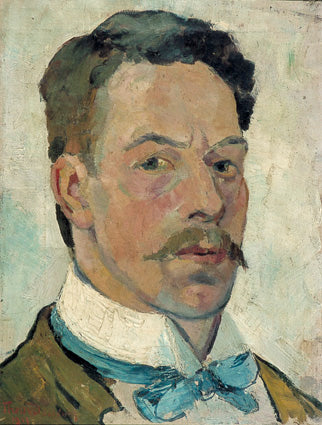Description
In the field of modern art, the work "self -portrait" of Theo Van Doesburg, made in 1913, is erected as a palpable testimony of the break with the past and the search for new forms of expression. This painter, outstanding representative of the STIJL movement, presents us with an self -portrait that is not only a representation of his own image, but also an exploration of the possibilities of color and shape.
The composition of the work is remarkable. Van Doesburg is portrayed using geometric planes that fragment their figure, forming a set where the human figure is broken down into lines and colors. The painting reveals a face that is inscribed within a two -dimensional matrix, where the proportion and symmetry cease to be strict and interspersed with abstract elements. This compositional construction is emblematic of the neoplasticist style that the artist defended, characterized by the reduction of form to the essential and an order based on verticality and horizontality.
The color in "self -portrait" also deserves a deep analysis. The palette used by Van Doesburg consists of primary tones, especially blue, red and yellow, combined with black and white elements. This choice is not arbitrary; Primary colors are fundamental in neoplasticism, symbolizing a search for universality in art. Each tone in this work seems to dialogue with each other, creating a dynamic balance that attracts and retains the viewer's gaze. In addition, the intensity of colors not only enhances the image of the artist, but also suggests the vitality energy that characterizes the artistic production of the early twentieth century.
One of the most intriguing aspects of this work is its link with the historical and cultural context in which it is registered. Van Doesburg, like other contemporaries, was influenced by the renewal aspirations sprouted in Europe after World War I. Its approach to abstraction and geometry could be interpreted as an answer to a world in transformation, where art became a vehicle for reconciliation and harmony. Thus, this self -portrait reflects not only a person image, but also the spirit of an era that sought to overcome chaos.
Although the characters or narrative elements may seem absent in the self -portrait, this void allows the viewer to concentrate on the very essence of the portrayed. Through the absence of superfluous details, Van Doesburg achieves a powerful connection between the figure and the environment, emphasizing its position as a creator within the artistic framework of its time.
The work can be seen as a precursor to other abstract manifestations that would develop in modern art. When studying "self -portrait", the viewer can appreciate the evolution of visual language that would later influence artists such as Piet Mondrian and, in extensions, subsequent movements such as concrete art and abstract painting.
Thus, "self-portrait" of Theo Van Doesburg not only stands as a self-representation, but as a fragment of a broader artistic discourse. Through its controlled geometry and color synthesis, this work invites reflection on the identity of the artist in the context of a world that constantly redefined. It is ultimately a manifestation of the desire to seek meaning and order amid the complexity of being and time, and an example of how art can serve as a mirror of the human condition.
KUADROS ©, a famous paint on your wall.
Hand-made oil painting reproductions, with the quality of professional artists and the distinctive seal of KUADROS ©.
Art reproduction service with satisfaction guarantee. If you are not completely satisfied with the replica of your painting, we refund your money 100%.

